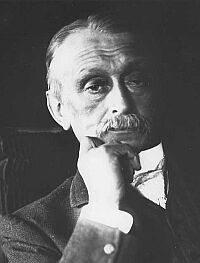Jacobus Kapteyn
Telescope
Jacobus Cornelius Kapteyn
(1851-1922)

Jacobus Cornelius Kapteyn was born in Barneveld, the Netherlands on 19th
January 1851. He studied at the University of Utrecht from 1868. He moved to
the Leiden astronomical observatory in 1875, and three years later became
the first Professor of Astronomy and Theoretical Mechanics at the University
of Groningen.
Apart from being an innovative astrophysicist,
Jacobus Kapteyn was a considerable figure in the promotion of international
cooperation in astronomy, and one of Holland's foremost men of science.
The abiding interest of his life
was the investigation of the structure of the Universe and the list of
his achievements reflects this. A doctor of physics, he only entered the
astronomical field when aged 24; his inaugural address on stellar parallax
marked the keystone of his career.
The University of Groningen could
boast no observatory at the time Kapteyn was appointed and, failing to
obtain proper funding for observatory buildings, he established an astrometrical
laboratory where he hoped to exploit the full potential of photography
in astronomy, then in its early days. His association with David Gill at
the Royal Observatory, Cape of Good Hope developed from his offer to measure
and reduce plates taken there. Thirteen years of work yielded the Annals
of the Cape Observatory, a catalogue of nearly half a million stars
between 18°S declination and the Pole, work done with help only from
unskilled assistants.
During the years of the measurement
and reduction of the Cape photographic plates Kapteyn was also active in
other fields, particularly the photographic determination of parallaxes.
In 1882 the parallaxes of only 34 stars were known: by the end of his life
the Groningen Publications had carried papers giving more than 10,000
parallax measures.
All this work tended to the general
aim of improving our knowledge of the stellar system. Growing naturally
from his work on annual parallax, the study of proper motion next claimed
his attention. The determination of absolute proper motions of neighbouring
stars will yield the Sun's motion towards the solar apex and in turn will
give an ever-increasing baseline for the determination of secular parallaxes.
This work directly led to the greatest single discovery of his life, that
of 'star streaming'. It had previously been assumed that the proper motions
of stars would be random. By analysis of proper motions in selected areas
of the sky, Kapteyn showed that stars were moving in two streams 140°
apart. This is today recognized as direct evidence of the rotation of our
Galaxy, though the full significance of the discovery was not realized
until after Kapteyn's death and the demonstration that some nebulae were
extragalactic, being indeed galaxies in their own right.
Kapteyn proposed international
collaboration in the analysis of the properties of the stars. Their magnitude,
proper motion, parallax, spectral class and radial velocities were to be
determined in measurements carried out according to his 'Plan of Selected
Areas'. He selected 206 areas distributed uniformly over the whole of the
sky and 46 areas near the galactic plane, and the results from all these
zones were to be treated statistically to form a picture for the whole
sky. This big effort represented the first major international collaborative
project in astronomy, involving over 40 observatories.
Only weeks before his death, some
of the results of his 'Plan' were published under the title 'First Attempt
at a Theory of the Arrangement and Motion of Sidereal System' in the Astrophysical
Journal. The conclusions described a lens-shaped island universe, whose
density decreased away from the centre. This galaxy was thought to be 40,000
light-years in size, the sun being relatively close (2,000 light-years) to
the centre. The discovery of interstellar extinction after Kapteyn's death
resulted in the estimated size of the galaxy being increased to 100,000
light-years, and the sun being relegated to a distance of 30,000 light years
from its centre. Though the general scheme of our Galaxy which Kapteyn outlined
was shown to be erroneous by the work of Leavitt, Shapley and Hubble, the
importance of the huge amount of work done by him was in the solid foundation
of astrometric data and analysis on which later generations have built
with confidence.
Kapteyn was a member of the French Academy of Science, a Fellow of the
Royal Society and a founder member of the International Astronomical Union.
He died in Amsterdam on 18th June 1922.
|

